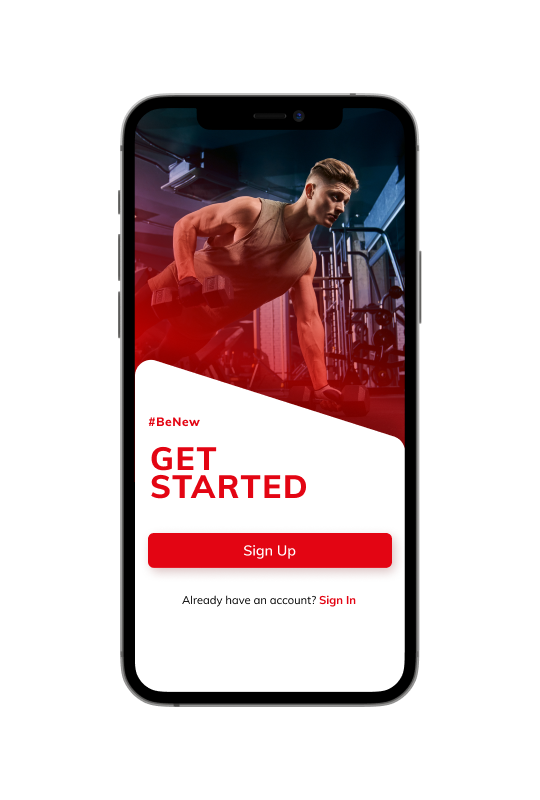Developing an AI-based fitness app is a journey that involves not just technology but also strategic planning. It’s about integrating artificial intelligence into fitness solutions to meet the rising demand for personalized and efficient workout programs. Apps like Fitbod have set a high standard in the industry, utilizing AI to offer customized workout plans, real-time feedback, and detailed progress tracking. This strategic approach makes fitness routines more effective and engaging.
In this guide, we will walk you through the essential steps to develop an AI-driven fitness app similar to Fitbod. We will cover the key aspects of planning, designing, and implementing features that utilize AI to enhance user experience and achieve fitness goals. We will also discuss potential challenges you might face and how to overcome them. From defining your app’s objectives to incorporating advanced AI technologies, this blog will provide clear, practical advice to help you build a successful fitness application.
Fitbod: Overview

Fitbod is more than a fitness app. It’s your personal trainer, conveniently accessible from your smartphone. The app’s user-friendly interface makes it comfortable for both beginners and experienced users. It generates customized workout plans based on your fitness goals, current level, and available equipment. Utilizing advanced AI and machine learning, Fitbod adjusts your workout routines according to your progress, ensuring that your exercises are both effective and suitable for your needs. Additionally, Fitbod provides a companion app for Apple Watch users, simplifying workout tracking and progress monitoring. In summary, Fitbod excels in delivering personalized fitness plans and adapting workouts to help users achieve their fitness goals.
How Does Fitbod Work?
Fitbod operates as a comprehensive virtual personal trainer by integrating advanced technology with personalized fitness planning. Here’s a breakdown of how the app functions:
- Initial Setup: You start by entering your fitness goals, experience level, and the equipment you have. This information forms the foundation for creating a personalized workout plan.
- Personalized Workout Plans: Fitbod uses AI and machine learning algorithms to design workouts that match your input. It suggests specific exercises, sets, reps, and rest periods based on your goals and progress.
- Logging Workouts: As you complete your workouts, you log details such as exercises performed, sets, reps, and weights used. This data is crucial for the app to track your progress and adjust future workouts.
- Progress Tracking and Adaptability: Fitbod monitors your workout history and muscle recovery and adjusts routines to ensure optimal results. It adapts to different fitness environments, whether you’re at home or using minimal equipment.
- Exercise Demos: To ensure correct form and safety, Fitbod provides demo videos for each exercise. This feature helps you perform exercises correctly and effectively.
- Companion App: For Apple Watch users, Fitbod offers a companion app that allows you to track workouts conveniently and receive real-time feedback.
Market Trends In AI And Fitness Market
The global market for AI in mobile apps is expected to grow from USD 20.2 billion in 2023 to about USD 251.1 billion by 2033. This represents an annual growth rate of 28.6% from 2024 to 2033. This expansion is largely due to the increased demand for personalized user experiences and the widespread adoption of smartphones. Additionally, advancements in 5G technology will further enhance AI capabilities, allowing for faster data processing and real-time interactions.

Similarly, the fitness app market is anticipated to grow from USD 4.9 billion in 2023 to approximately USD 25.9 billion by 2033, with a compound annual growth rate (CAGR) of 18%. Another forecast predicts that fitness app revenues will reach USD 6.86 billion in 2024 and grow at an annual rate of 7.96%, reaching USD 10.06 billion by 2029. These trends indicate significant opportunities for development in the AI and fitness app sectors.
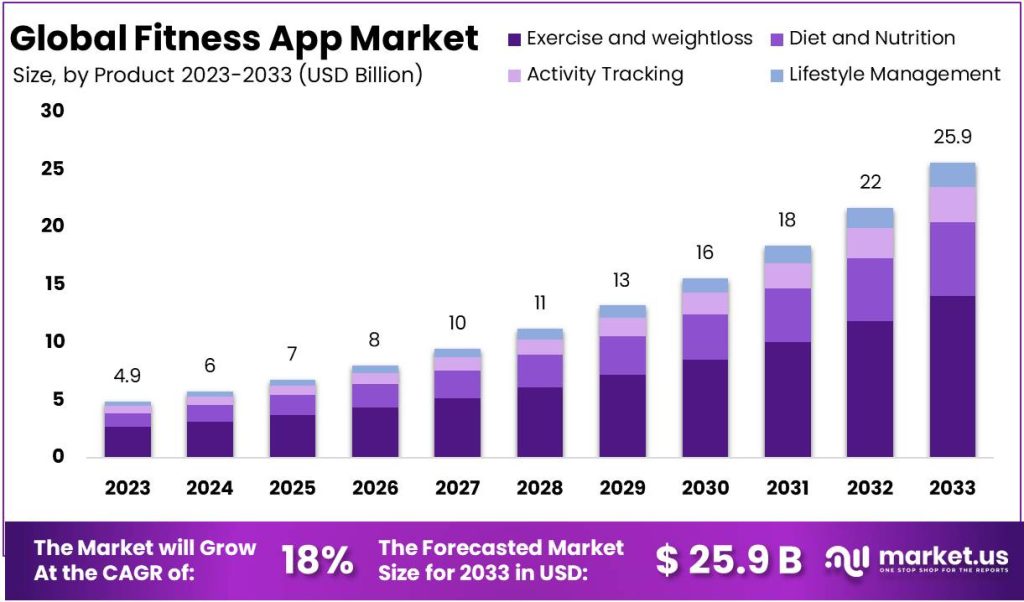
Benefits Of Developing An AI-based Fitness App Like Fitbod
Here are the top 10 benefits of developing an app like Fitbod:
- Personalized Workout Plans: AI creates personalized workout plans based on user goals, experience levels, and available equipment, ensuring a customized fitness experience.
- Enhanced Workout Efficiency: AI optimizes workouts by recommending specific exercises, sets, reps, and rest times to help users reach their goals more quickly.
- Continuous Adaptation: The app adjusts workout plans based on user progress, keeping the routines challenging and effective.
- Improved Exercise Technique: AI provides detailed instructions and demo videos to help users maintain proper form and avoid injuries.
- Data-Driven Insights: AI analyzes user data to offer actionable insights and recommendations for performance improvement.
- Increased Motivation: The app sets goals, tracks progress, and gives feedback to keep users motivated and accountable.
- Variety and Engagement: AI suggests new exercises and routines to prevent workout monotony and maintain user interest.
- Efficient Time Management: AI designs workout plans that fit into users’ busy schedules, supporting consistency in their fitness routines.
- Scalability and Cost Efficiency: AI-based apps are scalable and cost-effective, handling many users with minimal manual effort.
- Competitive Advantage: An AI-driven app provides a unique offering in the fitness app market, attracting and retaining users with advanced features.
Unique Features Of Fitbod
Fitbod stands out in the fitness app market with several distinctive features:
1. Comprehensive Workout Metrics:
The app tracks and analyzes data from workouts and offers detailed metrics to help monitor progress. These insights provide a clear view of training patterns and performance and aid in achieving fitness goals.
2. Customized Workouts:
Fitbod designs workout plans based on individual fitness goals, experience levels, and available equipment. It uses past workout data and preferences to create routines personalized specifically for users.
3. Muscle Usage Tracking:
Fitbod tracks the muscles engaged in each exercise and provides a comprehensive understanding of muscle engagement. This feature helps maintain a balanced workout routine and focus on specific muscle groups as needed.
4. Flexible Fitness Plans:
Fitbod allows the design of custom workout regimens by choosing exercises from its extensive library. This flexibility lets users adjust workouts to fit their preferences, equipment availability, and targeted muscle groups.
5. Corporate Wellness Program:
Fitbod For Work supports employee health and wellness by aligning fitness goals with company objectives. This program promotes overall employee well-being and offers a positive return on investment.
6. Affordable Pricing Options:
Fitbod offers cost-effective subscription plans. The yearly plan is available for $59.99, while the monthly plan costs $9.99 per month. Periodic discounts may also make the app more accessible to users.
Why Do People Prefer Fitbod App?
Fitness enthusiasts widely favor Fitbod due to its distinctive and efficient features. A key reason for its popularity is the app’s ability to design personalized workout plans. These plans are personalized to individual fitness goals, experience levels, and available equipment, ensuring each workout is highly relevant. Fitbod employs advanced AI and machine learning algorithms to adjust workout routines based on user progress continuously and optimizes each session. Other than that, Fitbod tracks detailed metrics like sets, reps, and weights, providing valuable insights for monitoring and improving performance. The user-friendly interface and demo videos in the app ensure correct exercise execution. Additionally, the Apple Watch companion app adds convenience for tracking workouts, and Fitbod For Work promotes corporate wellness, which is beneficial for businesses.
Overall, you can say that Fitbod’s unique combination of personalization, detailed tracking, and flexibility ensures a comprehensive and effective fitness experience, making it a leading choice among users.
7 Features That Can Enhance Your AI-Based Fitness App Like Fitbod
You can incorporate the following features in your AI-based fitness app similar to Fitbod and significantly enhance user experience and effectiveness:
1. Wearable Integration:
Integrate seamlessly with fitness wearables such as Fitbit, Apple Health, and Strava for comprehensive health tracking. This includes monitoring heart rate, sleep patterns, and step counts, providing a holistic view of users’ health metrics.
2. Community Engagement:
Integrate social and community features to foster motivation and a sense of belonging. Features like challenges, leaderboards, and social sharing can enhance user engagement and create a supportive fitness community.
3. Nutrition and Meal Planning:
Include comprehensive nutrition tracking and meal planning features to offer a wholesome approach to fitness. Users can manage their diet alongside their workout routines, leading to more balanced and effective results.
4. Injury Prevention And Recovery:
Implement features focused on injury prevention and recovery, such as exercises customized to avoid overworking specific body parts and recommendations for recovery routines. This helps users maintain a healthy and sustainable fitness regimen.
5. Virtual Coaching:
Offer virtual coaching sessions with professional trainers for personalized guidance and motivation. This feature provides users with expert advice and encouragement to enhance their fitness journey.
6. Gamification Elements:
Introduce gamification elements like badges, rewards, and achievements to keep users engaged and motivated. Gamification can make the fitness experience more enjoyable and rewarding.
7. Accessibility Features:
Ensure the app is accessible to users with disabilities by incorporating features like voice commands, adjustable text sizes, and screen reader compatibility. This inclusivity ensures all users can benefit from the app’s features.
How To Develop An AI-based Fitness App Like Fitbod?
Creating an AI-based fitness app similar to Fitbod involves several crucial steps, each requiring careful consideration and execution. Here’s a detailed guide to developing a robust and user-friendly fitness app:
1. Research And Planning
Begin by identifying your target audience, whether your app is intended for fitness novices, enthusiasts, or advanced athletes. Analyze Fitbod’s features, user reviews, and market performance to understand its strengths and user expectations. Additionally, other fitness apps like MyFitnessPal and Nike Training Club should be studied to identify gaps and opportunities. Define your app’s unique selling points (USPs) to differentiate it from competitors, such as unique features or an enhanced user experience.
2. Define Features And Functionality
When defining features for an AI-based fitness app, prioritize the core elements that should include personalized workout plans based on user goals, experience, and available equipment. Use AI-driven recommendations to suggest exercises, sets, and reps customized to the user’s progress. Implement muscle recovery tracking to prevent overtraining and optimize workout schedules. Provide detailed exercise instructions and demo videos to ensure the correct exercise form. Include comprehensive progress tracking and analytics to help users monitor their progress. Ensure the app has a user-friendly interface for ease of use and develop a companion app for wearables like the Apple Watch.
Moreover, you can also consider adding additional features to further enhance user experience and engagement, such as nutrition tracking to monitor dietary intake, community engagement features like challenges and leaderboards, virtual coaching sessions with professional trainers, and gamification elements such as rewards and achievement systems.
3. Design UI/UX
Create an intuitive and user-friendly interface that simplifies navigation. Develop detailed wireframes and interactive prototypes to visualize the app’s flow and functionality and ensure a smooth user experience. Use tools like Figma or Sketch for design and InVision for prototyping. Focus on creating a clean, responsive design that works well on various screen sizes. Apply user-centric design principles to ensure that each feature is easily accessible and visually appealing.
4. Development
In the development phase, build the user interface and ensure seamless integration with the backend. For frontend development, use React Native or Flutter to create a responsive and interactive user interface. Backend development should focus on creating robust server-side logic using Node.js, Python, or Ruby on Rails while ensuring efficient handling of data and API requests. Implement AI algorithms to enable personalized workout plans and dynamic adjustments based on user performance. Use TensorFlow or PyTorch to develop and integrate machine learning models that personalize workout recommendations. Utilize cloud services like AWS or Google Cloud for scalable infrastructure, ensuring that the app can handle increasing user loads and data storage efficiently.
5. Testing
Conducting comprehensive testing is essential to ensure the app operates seamlessly.
- Functional testing should be performed to confirm that all features work correctly, covering both core functionalities and edge cases, with automated testing tools like Selenium and Appium aiding in this process.
- Usability testing involves assessing the app with real users to gather feedback on its ease of use and overall experience, identifying any potential pain points or areas needing improvement.
- Performance testing ensures the app maintains optimal performance under various conditions, such as high user loads and different network environments, using tools like JMeter and LoadRunner.
- Lastly, security testing is crucial for protecting user data, which involves checking for vulnerabilities such as SQL injection, XSS, and CSRF using tools like OWASP ZAP and Burp Suite.
6. Launch And Maintenance
Optimize your app’s listing for better visibility in app stores through app store optimization (ASO). Use social media, influencer partnerships, and other marketing strategies to promote your app. Regularly collect and analyze user feedback to make continuous improvements. Keep the app updated with new features and performance enhancements, and address any reported issues promptly to maintain a smooth user experience.
By following these steps, you can develop an AI-based fitness app that not only competes with but potentially surpasses existing solutions like Fitbod.
Tech Stack For Fitbod Clone App Development
| Category | Technologies |
| Frontend Development | React Native, Flutter, JavaScript, Dart |
| Backend Development | Node.js, Django, Ruby on Rails, JavaScript, Python, Ruby, RESTful, GraphQL |
| Database | MongoDB, PostgreSQL, Firebase, Scalability, real-time sync |
| AI and Machine Learning | TensorFlow, PyTorch, Scikit-learn, Personalized plans, progress tracking |
| Cloud Services | AWS, Google Cloud, Microsoft Azure, Storage, computing, ML deployment |
| DevOps and CI/CD | Jenkins, GitLab CI, CircleCI, Git |
| Analytics and Monitoring | Google Analytics, Firebase Analytics, Mixpanel, New Relic, Datadog |
| Security | Data encryption, secure authentication, OAuth, SSL/TLS |
Timeline For Developing A Fitbod Clone App
Here’s a detailed timeline for developing a Fitbod clone app, broken down into key phases:
| Phase | Duration | Tasks |
| Research and Planning | 2-4 weeks | Market research, define features, create project plan |
| UI/UX Design | 4-6 weeks | Develop wireframes, create prototypes, finalize design |
| Frontend Development | 8-12 weeks | Implement designs, integrate with back-end APIs, conduct initial testing |
| Backend Development | 10-14 weeks | Set up database, develop APIs, integrate AI algorithms |
| Testing | 4-6 weeks | Functional, usability, and performance testing |
| Launch and Marketing | 2-4 weeks | Optimize app store listing, run marketing campaigns, gather user feedback |
| Maintenance and Updates | Ongoing | Regular updates, bug fixes |
| Total Estimated Time | 30-46 weeks |
Factors That Affect The Cost Of Fitbod Clone App Development
The factors that collectively determine the cost of developing a Fitbod clone app are:
- Features: Basic features like personalized workouts and advanced options such as nutrition tracking impact costs.
- Platform: Developing for both iOS and Android or using cross-platform tools like React Native affects expenses.
- Design: The complexity and quality of UI/UX design, including custom graphics – drive costs.
- Development Team Location: Costs vary based on whether developers are local or offshore.
- Technology Stack: Using advanced technologies and AI frameworks increases costs.
- Testing: Comprehensive functional, usability, and performance testing add to expenses.
- Maintenance: Ongoing updates and bug fixes contribute to long-term costs.
- Marketing: App store optimization and promotional activities impact the overall budget.
Here’s a concise table outlining the estimated costs to develop a Fitbod clone app:
| Development Phase | Cost Range |
| Planning and Research | $2,000 – $5,000 |
| Wireframes and Prototypes | $5,000 – $10,000 |
| Final Design | $10,000 – $15,000 |
| React Native or Flutter Development | $20,000 – $30,000 |
| Server-Side Development | $15,000 – $25,000 |
| Database Setup | $5,000 – $10,000 |
| API Development | $10,000 – $15,000 |
| AI Algorithm Development | $15,000 – $25,000 |
| Functional, Usability, and Performance Testing | $5,000 – $10,000 |
| App Store Optimization (ASO) | $2,000 – $5,000 |
| Marketing Campaigns | $5,000 – $10,000 |
| Maintenance and Updates | $5,000 – $10,000 per year |
| Total Estimated Cost | $10, 000 – $100,000 |
Top 5 Alternatives To The Fitbod App
Here are the top 5 alternatives to the Fitbod app:
1. Home Workout – Fitness Trainer
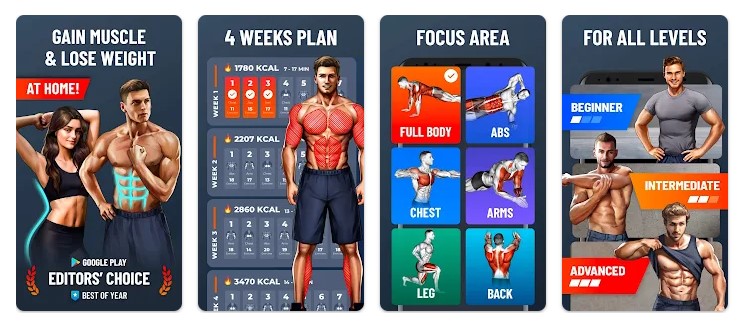
This app is designed for individuals who prefer to exercise at home. It offers a wide range of free workout routines, including hundreds of exercises, structured workout programs, and nutrition plans. The app is ideal for users who want to achieve their fitness goals without needing gym equipment, making it a versatile choice for home-based workouts.
2. SmartGym
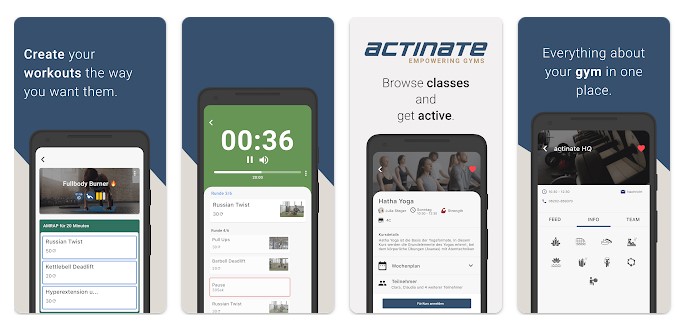
SmartGym provides a customized workout experience through advanced algorithms that cater to various fitness goals, including weight loss, muscle building, and endurance improvement. Users benefit from personalized feedback, practical fitness tips, and over 130 pre-designed workouts. This app is well-suited for those looking for a structured and diverse workout plan tailored to their individual needs.
3. StrongLifts
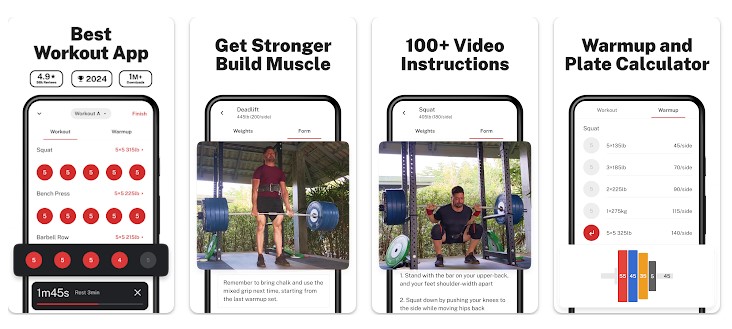
This app focuses on strength training and muscle building, acting as a personal coach through its targeted guidance and support. The app is tailored for users committed to strength and weightlifting goals, offering specialized features to track and refine lifting techniques. StrongLifts is ideal for those dedicated to improving their strength and achieving muscle-building objectives.
4. Workout: Gym Workout Planner

This app serves as a virtual personal trainer, providing users with comprehensive tools to enhance their gym sessions. It features detailed workout logs and various functions to track progress and optimize training. This app is perfect for gym enthusiasts seeking a well-organized approach to their workouts, ensuring effective and consistent exercise routines.
5. JEFIT
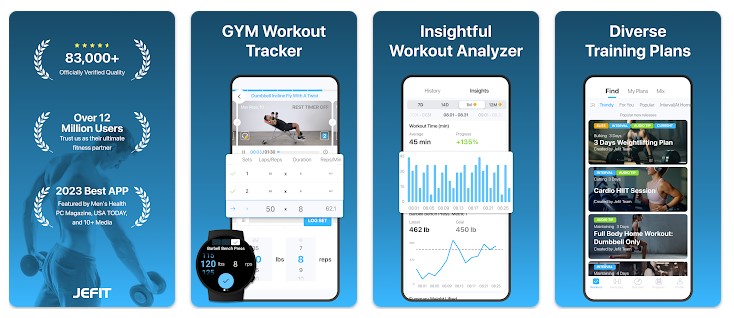
JEFIT offers an extensive exercise library with over 1,400 exercises, making it a valuable resource for detailed workout planning and body measurement tracking. The app provides comprehensive tracking tools and clear exercise instructions, catering to users who need a broad selection of exercises and want to monitor their progress in detail. JEFIT is well-suited for those seeking thorough and versatile fitness-tracking solutions.
Conclusion
Developing an AI-driven fitness app like Fitbod offers a promising path to delivering a highly customized fitness experience. By incorporating advanced AI technology, the app can generate personalized workout routines that evolve based on user progress and objectives. Focus on ensuring ease of use, integrating with wearable devices, and providing comprehensive feedback to maximize the app’s effectiveness. The increasing demand for personalized fitness solutions and the growing fitness app market highlight the potential for success. A methodical approach, from thorough research to continuous improvements, will position your app effectively and offer valuable support to users striving to meet their fitness targets.
Develop A Fitbod Like App With Idea Usher
Partner with Idea Usher to develop an advanced fitness app similar to Fitbod. Our team specializes in creating personalized, AI-driven fitness solutions that deliver customized workout plans based on individual goals and progress. We focus on integrating machine learning algorithms to enhance user experience, provide real-time feedback, and offer detailed progress tracking. With our expertise in app development, we ensure a seamless, user-friendly interface and effective integration with wearable devices.
Work with Ex-MAANG developers to build next-gen apps schedule your consultation now
FAQ
Is there a better app than Fitbod?
While Fitbod is highly regarded for its personalized workout plans, other apps like StrongLifts and JEFIT also offer unique features and strong user experiences. The best app depends on your specific fitness goals and preferences.
What is the best AI personal trainer?
The best AI personal trainer varies by individual needs. Apps like Freeletics and Vi Trainer are noted for their advanced AI capabilities, providing personalized workouts and real-time feedback. Each offers distinct features that cater to different fitness goals and preferences.
Is there a free AI fitness app?
Yes, there are free AI fitness apps available. Examples include MyFitnessPal and FitOn, which offer personalized workout recommendations and basic AI features at no cost. These apps provide valuable fitness guidance while allowing users to explore premium features optionally.
What is the difference between Fitbod and Fitnessai?
Fitbod focuses on personalized workout plans and progress tracking using AI to adapt routines. Fitnessai, however, emphasizes AI-driven recommendations for various fitness needs, including nutrition and overall wellness. Both offer unique features but cater to different aspects of fitness and user preferences.




















